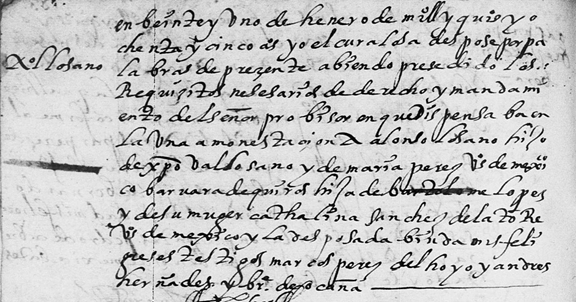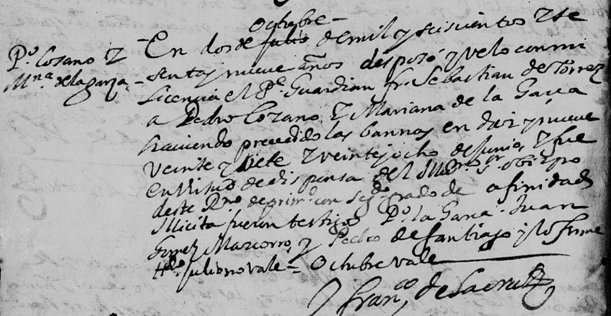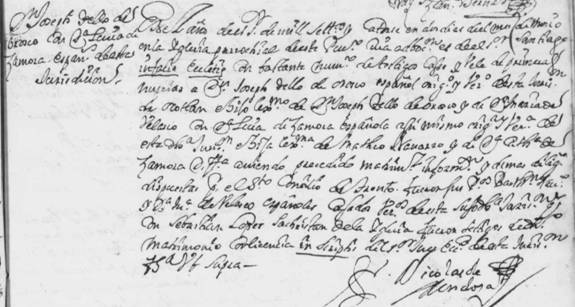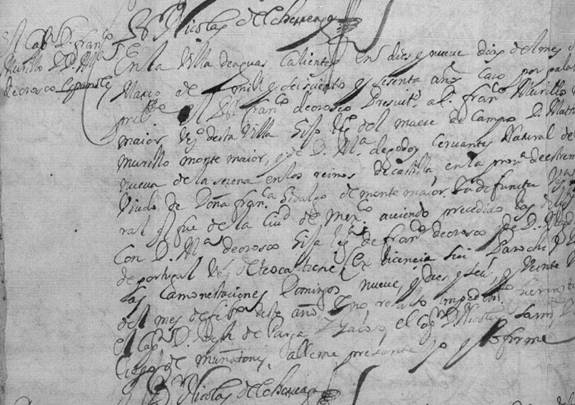|
THE SURNAME LOZANO: FROM
SPAIN TO MEXICO By John P. Schmal The
Surname Lozano The
surname Lozano has been
prominent in several parts of Zacatecas, Aguascalientes and Jalisco
since the arrival of the Spaniards in Nueva Galicia during the Sixteenth
Century. In the “Dictionary
of Surnames,” Patrick Hanks and Flavia Hodges indicate that
Lozano is a nickname for an elegant or haughty person – from the Old
Spanish, Locano
(splendid, later “good-looking”). According
to Richard D. Woods and Grace Alvarez-Altman, “Spanish Surnames in the
Southwestern United States: A Dictionary,” the surname Lozano
refers to an area of luxurious green. This source also indicates
that Lozano was originally a Castilian name from the mountains of León.
Some sources believe that the surname originated in ancient Segovia and
is the equivalent of Lozaza
from the Latin “lautianus” meaning
luxurious and sprightly. Origins
in Salamanca The
“Diccionario
heráldico y genealógico de apellidos españoles y Americanos”
states that one of the first notable members of this surname was Hugo
Lozano, a native of Segovia, who was the secretary of King Ferdinand III
(the Saint) who ruled from 1217 to 1230. However, over the centuries,
various houses of the surname Lozano have also arisen in Aragon, Navarra,
Asturias, La Mancha, Extremadura and Andalusia. The Lozanos in Aragon
took part in the conquest of the Region of Murcia (in southeastern
Spain) and the settlement of the town of Jumilla within Murcia. One
Gil Lozano, the son of Miguel Lozano, lived in the Villa de Biel in the
judicial district of Sos (Zaragoza) in the early Sixteenth Century.
He was the founder of one branch of Lozano’s living in Biel and
later in the Villa de Luna in the judicial district of Egea de los
Caballeros (Zaragoza). Another
branch of the Lozano’s started out in San Juan de Berrio in the
judicial district of Infiesto (Asturias) in the person of Alvaro (or
Alonso) Lozano, a native of that town, who married Gracia Rodríguez.
Some descendants of this family moved to and lived in Granada,
Sevilla and Cadiz during the next three centuries. In Vizcaya, a branch
of the Lozano family originated in the Villa de Bilbao. Pasajeros During the Sixteenth Century, a significant number of
Lozano’s left Spain for Nueva España (Mexico). Three of these
immigrants – listed in Pasajeros a Indias -- were:
Mexico City:
Asunción Parish The surname Lozano made an early appearance in Asunción Cathedral in Mexico City during the Sixteenth Century. On June 19, 1582, a Francisco Losano was married to Ana Rodriguez in the Church. And, a year later, on Sept. 27, 1583, another Francisco Losano was married to one Francisca Osorio. A few years later, on January 21, 1585, Alonso Losano, the son of Xpoval (Cristoval) Losano and Maria Perez, all residents of Mexico City, was married to Barbara de Quiros (Family History Library Film 35267). A copy of that record is shown below:
Although some of the Mexico City Lozano’s eventually moved on to other parts of the country, the surname is still fairly common in Mexico City and the Federal District today. Lozanos in
Aguascalientes Although it has not been absolutely verified at this time, Juan Lozano, a native of Lobón, Badajoz, Extremadura, Spain, and Ines Martinez are believed to be the ancestors of the Lozano family that settled in Aguascalientes in the early years of the Seventeenth Century. The name of Cristobal Lozano appears in the earliest parish registers of that city. On November 29, 1609, two Indian laborers employed by Cristobal Lozano were married in the Church of Aguascalientes. In 1614, he is first mentioned as a padrino at the wedding of a couple. Then, on April 1, 1619, Juana Lozano, the daughter of Cristobal Lozano and María de Isla, was married to Hernando de Velasco, a resident of Zamora (the son of Diego Arias Puebla y Maria de Velasco, natives of Valladolid). At the same time, Juana’s parents were still in the process of building their own family in the Hacienda de Xiconaque. Several of Cristóval Lozano and María de Isla’s children were baptized in the early years of the Villa, including Leonor (May 22, 1617) and Magdalena (September 7, 1619). Although Lozano has been a very common surname in parts of Aguascalientes, it was equally prevalent south of Aguascalientes in Nochistlán (Zacatecas) and Jalostotitlán (Jalisco). Jalostotitlán
(Jalisco) Lozanos The Lozanos also made an early appearance in Jalostotitlán, which is about 49 miles (78 kilometers) almost directly south of Aguascalientes. Their first recorded marriage in that parish took place on October 17, 1707 when Benito Lozano, the son of Fulgencio Lozano and Juana Casillas, married Rosa Francesca (whose parents’ names were not given – “hija de padres no conocidos”). At this early stage, many Lozanos lived in the town because more than half a dozen served as padrinos at the marriages of other people in the first few years. The second Lozano to get married in Jalos was Jacinto Lozano (a widower) who, on Oct. 24, 1712, was married to Lugarda Enriquez del Castillo. The five or six Lozanos living in Jalos at this time were prolific families and, as a result, the surname flourished over the next few decades and today, anyone who has ancestors from Jalostotitlán more than likely has Lozano ancestors. Lozanos of
Zacatecas Finding the Spanish origins of Mexican families can be difficult when you consider that the Atlantic journey for many families took place several centuries ago. A Zacatecas will dated September 9, 1674 described the testament of one Pedro Lozano. Among other things, the will said that Pedro Lozano was the son of Francisco Lozano and Teresa de Alcolea (both deceased) who were residents of “Lugar de Campisarcalos, jurisdiccion de la villa de Miedes, Obispado de Siguenza” (in Zaragoza). Pedro’s own wife was Antonia de Urquicu and his children were listed: Pedro, Francisco, Ignacia, Joseph (a priest) and Teresa. Their descendants appear to be inhabitants of Monterrey (Nuevo Leon). José Luis Vasquez y Rodríguez de Frías, in masterpiece “Genealogía de Nochistlán Antiguo Reino de la Nueva Galicia en el Siglo XVII Según sus Archivos Parroquiales,” discusses several dozen of the earliest families in that area. Among the early lineages discussed by José were:
Lozanos of
Monterrey The Monterrey Cathedral marriage records start in 1667 and are available on Family History Library Film 605179. One of the earliest marriages in this book is the October 2, 1669 marriage of Pedro Lozano and Mariana de la Garza, which we have reproduced below:
Capitan Pedro Lozano and his wife had eight children between the years of 1670 and 1687 and many of these descendants continued to live in Nuevo Leon for many generations. Capitan Pedro Lozano died on April 20, 1708 and was buried on the same date in the chapel of San Francisco Javier in Monterrey. His wife died nine years later, also in Monterrey. Their descendants are shown at the following link: http://www.somosprimos.com/inclan/pedrolozano.htm According to Kimberly Powell, “Meanings of Hispanic Surnames,” Lozano is the 51st most common surname in Spain, with an estimated 39,000 people bearing the surname. The surname is also believed to be fairly prevalent in many regions of Mexico today. Copyright
© 2014 by John P. Schmal. All Rights Reserved. Sources: Archivo
General de Indias. “Pasajeros a Indias: Libros de Asientos” (Sevilla, 1978). De
Atienza, Julio. “Nobiliario Español: Diccionario Heraldico de Apellidos Españoles y de
Titulos Nobiliarios” (Madrid, 1959). García
y Carraffa, Alberto and Arturo. “Diccionario
Heráldico y Genealógico de Apellidos Españoles y Americanos”
(1920-1963), 86 volumes. Hanks,
Patrick and Hodges, Flavia, “A
Dictionary of Surnames” (Oxford: Oxford University Press,
1988). Iglesia Catolica,
Catedral (Monterrey, Nuevo Leon). “Registro Parroquiales,
1667-1968.” FHL Microfilm #605179. Inclan, John D. “The
Descendents of Captain Pedro Lozano Rodriguez
And Dona Marianna de la Garza y Rocha” Online: <http://www.somosprimos.com/inclan/pedrolozano.htm>. Méndez
de Torres y Camino, Daniel Alejandro. “Archivos
Parroquiales de Aguascalientes: Siglo XVII” (San Jose,
California: 2011). “Notarias
of Felipe de Espinoza, Caja 02, Experiente de 1674.” From: “Gonzalez
Direct Lines - Person Sheet.” Available at: <http://www.currays.net/Gonzalez%20Web%20Project/ps05/ps05_080.htm>. Powell, Kimberly.
“Spanish Surnames & Origins: Meanings of Common Hispanic Last
Names.” Online: <http://genealogy.about.com/od/surname_meaning/a/spanish_names-2.htm>. Vasquez y Rodríguez de Frías, José Luis, “Genealogía de Nochistlán Antiguo Reino de la Nueva Galicia en el Siglo XVII Según sus Archivos Parroquiales” (2001). Woods,
Richard D. and Alvarez-Altman, Grace. “Spanish
Surnames in the Southwestern United States: A Dictionary” (G.
K. Hall, Boston, 1978).
|



